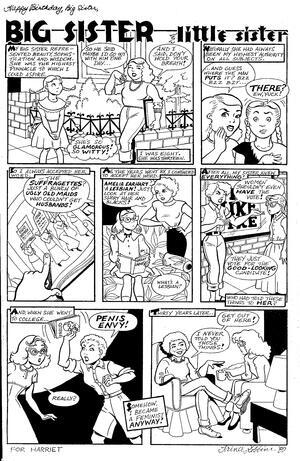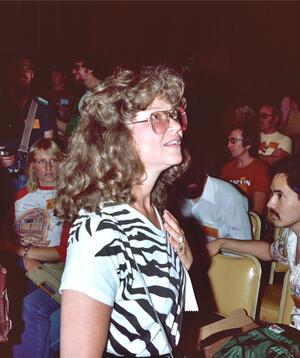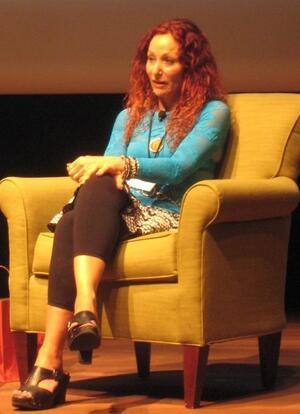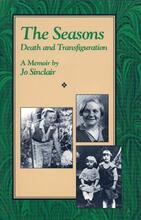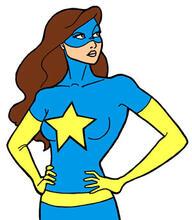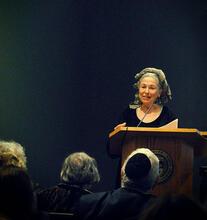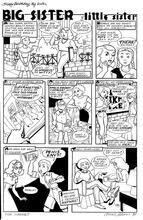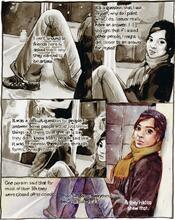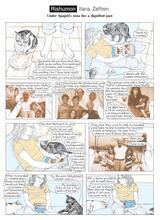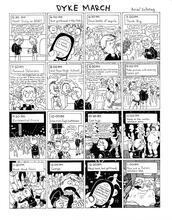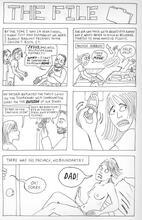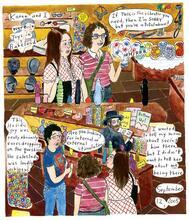Jewish Women’s Comics and Graphic Narratives
The history of Jewish women’s comics and graphic novels can be traced back to early and mid-20th-century progenitors, including artist Charlotte Salomon and cartoonists Hilda Terry, Lily Reneé, and Friedel Stern. With the underground comics scene of the late 1960s/early 1970s, several Jewish women, especially Trina Robbins, Aline Kominsky-Crumb, and Diane Noomin, laid the groundwork for the themes, styles, and communal ties that would be taken up by the post-underground. In the 21st century, the works of Jewish women in comics and graphic novels is booming, with many individuals focusing on autobiographical modes and/or on using comics to explore various aspects of contemporary and historical Jewish lives and identities.
Early Progenitors
Recent attention to connections between comics, graphic narratives, and Jews can be largely traced to the publication of two North American literary texts that subsequently received Pulitzer Prizes: Art Spiegelman’s Maus I and Maus II (1986, 1992) and Michael Chabon’s The Amazing Adventures of Kavalier & Clay (2000). These acclaimed works led many comics historians and practitioners to recognize an often-heavy correlation between Jewish creators and producers, Jewish subjects and themes, and twentieth-century comic books, comic strips, and cartoons.
But even as comics historians unearthed a genealogy of Jewish male creators in comics, Jewish women remained almost absent from any such history, except as occasional side-characters. Brooklyn-born cartoonist Will Eisner, who popularized the term “graphic novel” in the late 1970s with his books of comics recounting Jewish-American immigrant life, most notably included Jewish women characters in his stories, though they were usually depicted in heavily stereotyped, often derogatory ways. In addition, some Jewish women worked as cartoonists in the United States in the mid-twentieth-century, often publishing uncredited work with large publishing houses; these early comics did not engage directly with Jewish subjects (except, on occasion, via plots about World War II).
Early Jewish women comics pioneers include Hilda Terry, born in 1914 in Newburyport, Massachusetts. Terry was best known for her syndicated newspaper cartoon strip, Teena (1944-1964), about a prototypical American "teen" girl. She was the first woman cartoonist admitted to the National Cartoonists Society, in 1950. In her 1989 self-published work, Does God Eat Us?, a lightly illustrated prose work, Terry explores questions related to her Jewish identity. A second significant early Jewish female cartoonist was Lily Reneé Phillips. Born in 1921 in Vienna, Austria, Phillips escaped the Nazis via the Kindertransport and eventually moved to the U.S. Best known in comics by her pseudonym, L. Reneé, she was hired in 1942 by the New York-based comics publisher Fiction House, and she composed features and colored and inked comics there until 1949. In addition to these two American-based cartoonists, Friedel Stern, born in Germany in 1917, was long known as the first female Israeli cartoonist. Stern first began publishing illustrations within the Israel Defense Forces and later became known for her humorous illustrations commenting on everyday life in Israel. Stern also worked as a graphic designer and a lecturer at the Bezalel Academy in Jerusalem.
Artist Charlotte Salomon, born in Berlin in 1917, is also sometimes cited as an early example of a female Jewish creator of graphic narrative. Translated from the German as Life? Or Theater?, the work that garnered her this recognition is a difficult-to-categorize narrative work of art that includes over 700 small paintings with accompanying texts, captions, and overlays. Salomon’s work, which references opera, modernist art, and German Expressionist film, is not a work known to have been necessarily influenced by comics; nonetheless, her investment in using pictures and words to tell stories largely based on her autobiographical history, as well as her engagement in family history and its relation to a sense of self and identity, prefigures the works of many contemporary Jewish women cartoonists.
Underground Comix
The history of Jewish women and comics can most clearly be traced back to the underground comics (or comix) scene of the late 1960s and early 1970s, largely centered in San Francisco, California, and particularly to the emergence of comics collections organized and composed entirely by women. In 1970, Trina Robbins and Barbara “Willy” Mendes, both Jewish, spearheaded the publication of the first comic book produced entirely by women, titled It Ain’t Me, Babe. Soon after, a collective of women cartoonists was formed. Between 1972 and 1992, this collective put out the highly influential anthology Wimmen’s Comix, with seventeen issues in all edited by one or several women cartoonists; these volumes were later collected by the Seattle-based publisher Fantagraphics as The Complete Wimmen’s Comix (2016), edited by Robbins. The Jewish women cartoonists first published in Wimmen’s Comix, and the themes and storylines most evident in their works, set the landscape for the exciting, diverse output of Jewish women’s comics and graphic narratives that would thrive in the late twentieth and early twenty-first centuries.
Of the 115 eventual contributors to Wimmen’s Comix, and more broadly of the women who got their starts in this underground comix moment, the following Jewish women cartoonists stand out for the content of their works, their personal histories, and/or the influence they had on the world of comics.
Trina Robbins
At the vanguard of women’s comics culture and output is Trina Robbins, an artist, editor, and historian born in 1938 in Brooklyn, New York, who has spent much of her career focused on the promotion of women in comics. After she co-founded and edited the first all-women comic book, It Ain’t Me, Babe, Robbins went on to play a serious part in the collective that published Wimmen’s Comix. Robbins’s work was included in all but a few issues of Wimmen’s Comix, and she was also a co-editor of the important 1988 collection, Strip AIDS USA. Robbins has published a number of books of comics history centering women as readers and creators, including From Girls to Grrrlz (1999) and The Great Women Cartoonists (2001). She has also composed numerous graphic biographies of famous women, such as Elizabeth Blackwell: America’s First Woman Doctor (2006) and Nell Brinkley and the New Woman in the Early 20th Century (2001). While much of Robbins’s work does not specifically address Jewish content or themes, she wrote the storyline for a graphic biography about the aforementioned Jewish cartoonist who escaped from the Nazis, Lily Reneé: Escape Artist (2011). More recently, she edited a collection of short stories written in Yiddish by her father, Max B. Perlson, and published initially in 1938 as A Minyen Yidn un Andere Zakhn. Robbins translated the work as A Bunch of Jews and Other Stuff (2017), and she found various artists, many of them Jewish women cartoonists, to adapt the stories into comics. In her introduction to the book, Robbins writes of the project as a return to a background from which she had, in her earlier years, attempted to assimilate away.
Diane Noomin
Born in Brooklyn in 1947, Noomin was involved early on in the underground comix scene. Along with Aline Kominsky-Crumb, she was one of few women whose published comics referenced her Jewish background directly, as revealed by her early two-page comic, “The Agony and the Ecstasy of a Shayna Madel,” subtitled “The epitome of the Perfect Pretty Jewish Girl” and published in Wimmen’s Comics #3 (1973). Noomin is best known for her long-running character, DiDi Glitz, an over-the-top suburbanite single mother with a signature exaggerated blonde bouffant, whose sexual and romantic adventures are recorded in graphic, expressively stylized comics. In later publications, Noomin includes a more realistic alter ego in conversation with Glitz, as in her groundbreaking “Baby Talk: A Tale of 4 Miscarriages” (1995). Noomin has described her famous Glitz character as not overtly Jewish, but still part of a Jewish genealogy of sorts, not least because she is an exaggerated alter ego for Noomin herself. Noomin is also known for pioneering, along with Aline Kominsky-Crumb, another all-women comics anthology, titled Twisted Sisters and first published in 1976. Kominsky-Crumb and Noomin started the series after they broke with the Wimmin’s Comics collective, for aesthetic reasons and because of a difference of opinion in how the anthologies should be put together. The subsequent paperback collections of previously published work, Twisted Sisters: A Collection of Bad Girl Art (1991) and Twisted Sisters 2: Drawing the Line (1994), became important outlets for the broader dissemination of comics by women. Noomin is also the editor of a comics anthology influenced by the #MeToo movement, titled Drawing Power: Women’s Stories of Sexual Violence, Harrassment, and Survival (2019). The collection brings together short comics by over sixty contributors, including a number of Jewish women cartoonists.
Aline Kominsky-Crumb
More than all the other underground Jewish women cartoonists, Kominsky-Crumb’s works have been the subject of sustained academic studies, not least because of her groundbreaking, frank autobiographical depictions of sexual and emotional trauma. Dubbed the “godmother” of autobiographical women’s comics by scholar Hillary Chute, Kominsky-Crumb published her first piece in 1972, a five-page strip titled “Goldie: A Neurotic Woman” and featured in Wimmen’s Comics #1. In Goldie, one of Kominsky-Crumb’s longstanding comics personas is first pictured as a happy child wearing a Jewish star; following puberty, she experiences an often-agonizing life at home and in school. Goldie later marries a Jewish man, partly to please her mother, and the comic ends when she leaves the marriage, breaks free from worrying about societal and familial pressures, and decides to “live in my own style!” Kominsky-Crumb’s autobiographical comics include direct and indirect commentaries on her Long Island Jewish suburban childhood throughout, especially on the materialism and class anxiety of some of the people she grew up with. These works are collected in Love That Bunch (1990; reprinted in 2018) and Need More Love: A Graphic Memoir (2007). In addition, she has collaborated on a number of comics with her husband, famous underground cartoonist Robert Crumb; these have been published in The New Yorker and collected in Drawn Together: The Collected Works (2012). Kominsky-Crumb is also known for her editing work, including in relation to Twisted Sisters, as well as her work editing several issues of the well-known underground comics anthology, Weirdo, founded by Crumb.
Important Themes and Works from the Post-Underground
The lives and works of these three Jewish women cartoonists, whose careers are largely rooted in the underground period, anticipate many of the themes, styles, and concerns of later Jewish women cartoonists, particularly in the United Kingdom, United States, Canada, and Israel. These include explorations of a variety of affective styles and registers, from bawdy humor and satire to unaffected sincerity, as well as texts that highlight the work of other women and marginalized groups, as editors, biographers, or collaborators. In addition, these early cartoonists anticipate later Jewish American women cartoonists’ experimentations in and across a variety of genres and styles. Kominsky-Crumb’s influence in particular—especially when it comes to tackling taboos and difficult subjects through autobiographical experimentations—cast an indelible mark.
The following categories gather some of the most important and influential works of the post-underground, mainly as composed by self-identified Jewish women cartoonists and meant for adult audiences. Though the emphasis is on book-length works and shorter pieces that are easier to track down, this list is only an entry point into the much wider world of Jewish women and comics and graphic narratives. Many works transcend more than one of the following categories.
Motherhood: Love, Anxiety, and Loss
Many Jewish women cartoonists have explored motherhood from a variety of angles, a theme that can be traced back to Noomin’s and Kominsky-Crumb’s early works. The emphasis is often on the daily ins-and-outs of parenting—a theme that sometimes relegates such reflections to short, sketchier work that can be quickly posted online, via blogs and social media, or collected later on. Stand-out works include Lauren Weinstein’s “Perfect Maine Vacation” (first published in The Guardian, June 30, 2016) and “Carriers: A Webcomic on Health, Luck, and Life” (first published in Nautilus, June 23, 2014), Miriam Libicki’s “Who Gets Called an ‘Unfit’ Mother” (first published in The Nib, January 11, 2019), Sarah Lightman’s The Book of Sarah (2019), and Sarah Glidden’s “Father’s Days” (first published in Topic, Issue #12, June 2018). In line with Noomin’s groundbreaking comics on her experiences of miscarriage, Jewish women cartoonists have also used comics to tell moving stories of infertility and loss, as in parts of Sarah Glidden’s digital minicomic, Ajonjolí Diary (2019), Phoebe Potts’s graphic memoir, Good Eggs (2010), and Emily Steinberg’s online comic, “Broken Eggs” (originally published in Cleaver Magazine, September 10, 2014). Shira Spector’s recently published graphic memoir, Red Rock Baby Candy (2021), set in Montreal and Toronto, explores grief and pregnancy loss as experienced by a self-identified Jewish lesbian “drama queen” artist. Cartoonist Leela Corman has published several powerful comics about the death of her young child, Rosalie, and her grief in the aftermath to her loss. These can be found in her collection, We All Wish for Deadly Force (2016).
The Body in Pain
A number of Jewish women cartoonists have used comics, a medium often recognized as a natural fit for expressions of embodiment, to tell stories of illness as experienced by themselves or others. The umbrella term Graphic Medicine is sometimes used to refer to such works in comics. Miriam Engelberg, who died of cancer in 2006, used a blog to publish her wry, direct, and often humorous comics about the daily ins-and-out of living with cancer, until just weeks before her passing. These were collected as Cancer Made Me a Shallower Person (2006). Comics writer Joyce Brabner collaborated with her long-time partner, the autobiographical comic book writer, Harvey Pekar, to produce a script for Our Cancer Year (1994), a graphic memoir tracking Pekar’s cancer diagnosis and final year of life. Brabner has also written fictional comics featuring Jewish characters and addressing the early years of the AIDs crisis. Ellen Forney gives a medical history of the Jewish side of her family in her renowned graphic memoir, Marbles: Mania, Depression, Michelangelo, and Me (2012), a work tracing her struggles with bipolar disorder. And Emily Steinberg’s “Mid-Century Hipster” (originally published in Cleaver Magazine, June 3, 2019) and “Paused” (originally published in Cleaver Magazine, June 6, 2018), explore hip surgery and menopause, respectively. A number of Jewish women cartoonists have also composed comics about caring for a terminally ill loved one, or about the aftermath of losing a parent or spouse. These include New Yorker cartoonist Roz Chast’s bestselling Can’t We Talk About Something More Pleasant? (2014), Vancouver-based cartoonist Sarah Leavitt’s Tangles: A Story About Alzheimer’s, My Mother, and Me (2010), and Israel-based American artist Judith Cohen Margolis’s Life Support: Invitation to Prayer (2019). In American Widow (2008), Alissa Torres chronicles her experiences of losing her husband in the 9/11 attack and of giving birth and trying to resume her life in the months following. Though the styles of these works are invariably different, they are linked by an effort to communicate experiences that are often difficult to express.
Families and Everyday Lives
Many Jewish women cartoonists, like many Anglophone and Franco-Belgian cartoonists more generally, have, particularly starting in the 1990s, engaged with the form in order to tell short and longform stories rooted in everyday experiences and personal histories. These autobiographical comics often grapple with contemporary Jewish identity, as with Vanessa Davis’s 2010 collection, Make Me a Woman (2010); Miss Lasko-Gross’s two volumes of autobiographical comics, Escape from “Special” (2007) and A Mess of Everything (2009); and Liana Finck’s experimental, semi-autobiographical graphic work, Passing for Human (2018). Notable autobiographical cartoonists whose work does not engage as directly with Jewish content include Sophie Crumb, known especially for her collaborations with her parents as well as for her sketchbooks; Laurie Sandell, whose graphic memoir, The Imposter’s Daughter (2010), tracks an unusual childhood; and Ariel Schrag, best known for her four-year high school diary told in comics, in which she explores her sexuality, especially Likewise (2009), as well as her most recent collection of autobiographical pieces, Part of It (2018). Two noteworthy Israeli cartoonists who weave fantastical elements into their autobiographical works are Racheli Rottner, whose graphic memoir, The Other Side of the World (2008), explores alienation and adolescence, and Ilana Zeffren, best known for her comic strip “Rishumon” (2006-2013) and her graphic narrative, Sipur Varod (translated as A Pink Story, 2005), a work exploring LGBT life and history in Israel. Miriam Libicki, an Israeli-American artist, grapples with questions of sexuality and identity in her long-running, self-published, and partly collected series, Jobnik! (2008).
Jewish Women, Then and Now
A number of Jewish women cartoonists have used the form to explore collective Jewish histories from a variety of angles, many playing with the form in order to convey connections and disjunctions between various pasts and the present. Hungarian-born Miriam Katin has published two full-length works detailing her experiences, first as a child during the Holocaust in We Are On Our Own (2002), and later with the lingering after-effects of childhood trauma in her more aesthetically playful Letting It Go (2013). Various cartoonists have examined what it means to live as descendants of survivors, as in Toronto-born artist Bernice Eisenstein’s I Was a Child of Holocaust Survivors (2007), a book told in prose with accompanying illustrations and later adapted into an animated film by the same name (2010). Amy Kurzweil tracks three generations in her graphic memoir, Flying Couch (2016), in which she includes adaptations of her grandmother’s oral testimony of survival and escape. Kurzweil has also published related short pieces online, as in “Crossing Over” (first published on The Believer, August 1, 2018), a comic in which she recounts a visit to the Museum of Jewish Heritage to experience avatars telling their Holocaust testimony. Emil Ferris’s 2017 fictional tome, My Favorite Thing is Monsters, toggles between Chicago in the 1960s and Nazi Germany to help 10 year-old Karen Reyes better understand the history of her murdered upstairs neighbor, Anka Silverberg, a Holocaust survivor.
Some Jewish women cartoonists have focused on experiences of immigration, as in Leela Corman’s fictional work, Unterzakhn (2012), which tracks the trajectories of two sisters growing up on the Lower East Side in the early the twentieth century, and Liana Finck’s A Bintel Brief: Love and Longing in Old New York (2014), which interweaves translated and adapted letters from the longstanding Yiddish advice column with a fantastical story about a semi-autobiographical character encountering those letters. Several cartoonists have engaged with experiences of immigration directly, through their own family histories, as in Julia Alekseyeva’s Soviet Daughter: A Graphic Revolution (2017), a book that connects the narrator/protagonist’s experiences of growing up in the United States with her grandmother’s life in the former-Soviet Union, and Anya Ulinich’s Lena Finkle’s Magic Barrel (2014), a semi-autobiographical work about a Brooklyn-based single mother of two young girls looking back on her childhood in Moscow and her immigration experience.
Telling Their Lives
Graphic novels have often been viewed as a fitting outlet for biographical works, as there is often a presumption that younger audiences will more easily access life histories told in pictures as well as words. While many such works are aimed at younger audiences, Sharon Rudhal, another cartoonist involved in the underground, tells a sophisticated story in A Dangerous Woman: The Graphic Biography of Emma Goldman (2007). Important graphic biographies of Jewish women composed by men include Anne Frank’s Diary: The Graphic Adaptation (2018), adapted by Ari Folman and David Polonsky, and The Three Escapes of Hannah Arendt: A Tyranny of Truth (2018), by Ken Krimstein. As a body, graphic biographies tend to be more chronologically and conservatively structured, but these latter works especially reflect the ways that comics can emphasize the complex relationship between inner lives and external events.
A Politics of Engagement
Given the long history of comics, and especially cartooning, as a form of political engagement, it should come as no surprise that a number of Jewish women cartoonists are deeply engaged in using the form to respond to contemporary life and events with an activist slant. American comics journalist Sarah Glidden has written two longform works of comics journalism: How to Understand Israel in 60 Days or Less (2011), in which she grapples with Israel’s contentious history and contemporary politics through the lens of her own experiences there, and Rolling Blackouts: Dispatches from Turkey, Syria, and Iraq (2016). New Jersey-based cartoonist Lauren Weinstein addressed contemporary politics, often in conversation with tidbits from her personal life, in a strip for the Village Voice, which ran from 2016 to 2018. Cartoonist Rutu Modan, whose works are among the few by an Israeli artist to have been translated from Hebrew into English, has published a number of fictional books that reflect on the politics of contemporary Israeli life, including Exit Wounds (2007), about a fictional suicide bombing in Tel Aviv, and The Property (2013), which follows an Israeli granddaughter as she takes a “roots trip” back to Poland with her grandmother. Modan is part of the famous Israeli comics group, Actus Tragicus, which she founded in 1995 with Yirmi Pinkus and which has five members, including two other women: Mira Friedman and Batia Kolton. United Kingdom-based Corinne Pearlman had a regular strip, “Playing the Jewish Card,” including explorations of British Jewish identity, published in The Jewish Quarterly between 2009 and 2011. And finally, several cartoonists engage with politics from a personal point of view. Mira Jacob’s Good Talk (2019) is a memoir composed through collage, in which she recounts experiences and conversations related to being a woman of color raising her son with her Jewish husband after Donald Trump was elected president, while Nora Krug’s Belonging: A German Reckons with History and Home (2018) is a work in which the non-Jewish German-born author wrestles with her childhood through the lens of being a woman in her thirties living in New York, now married to a Jewish man.
Art Comics
A number of Jewish women cartoonists have created works that highlight drawing and painting, design, and illustration. These include Maira Kalman, best known as a painter and illustrator of children’s books and for her New Yorker covers. Some of her most important works of images paired with words, which integrate her familial history in Eastern Europe and later in Israel, include My Favorite Things (2014) and Sara Berman’s Closet (2018). Kalman also recently created illustrations to pair with Gertrude Stein’s The Autobiography of Alice B. Toklas. Disability activist Riva Lehrer has dedicated her professional lift to writing, painting, and drawing about what she describes as the “socially challenged body.” Her 2020 memoir, Golem Girl, mixes illustration, photography, and writing to tell the story of growing up with spina bifida and eventually finding a community of activists, artists, and educators invested in issues of embodiment. Keren Katz is an Israeli cartoonist whose short works and books are drawn in characteristically long, lean lines, with surreal characters and poetic, fragmented prose interspersed throughout. The Academic Hour (2017), written in English, is a longform example of Katz’s work, but the prolific artist has published numerous short pieces in individual small books as well as collections.
Cartoons
The single-panel cartoon, capable of making a point or telling a story in potent shorthand, has a long history in the world of cartooning, political and otherwise. Israeli-born artist Nurit Karlin was one of the first women to hold a regular gig drawing cartoons for the New Yorker. Roz Chast joined her in 1978, and her witty, neurotic, unusually gritty style and topic matter have since become fixtures at the magazine. More recently, Jewish women cartoonists like Liana Finck and Amy Kurzweil have had their works displayed in the magazine, in print and online. Finck also has an exceptionally wide following on the social platform, Instagram. She regularly posts cartoons and sketches there, commenting, often with a feminist slant, on everything from politics to art to the trials and tribulations of everyday urban life in twenty-first century America. Some of these cartoons were recently compiled in a collection, Excuse Me: Cartoons, Complaints, and Notes to Self (2019).
Conclusion
Session on "Jewish Women and Comics" for the Jewish Women's Archive's Global Day of Learning, in celebration of the launch of the Shalvi/Hyman Encyclopedia of Jewish Women, June 27, 2021. Featuring Tahneer Oksman in conversation with Betsy More.
Though it would be reductive to settle on one style, theme, or mode for the expression of Jewish women cartoonists, contemporary or otherwise, certain general trends should be noted. These include a penchant for the autobiographical, an investment in breaking taboos or addressing subjects often masked or avoided, and an awareness of a community beyond the individual artist, whether of Jews, women, cartoonists, or artists, whose influence can often be detected in close readings of these lives and works.
Baskind, Samantha, and Ranen Omer-Sherman, eds. The Jewish Graphic Novel: Critical Approaches. New Brunswick, NJ: Rutgers University Press, 2008.
Buhle, Paul. Jews and American Comics: An Illustrated History of an American Art Form. New York: The New Press, 2008.
Chute, Hillary L. Graphic Women: Life Narrative and Contemporary Comics. New York: Columbia University Press, 2010.
Clementi, F.K. “The JAP, the yenta, and the mame in Aline Kominsky Crumb’s graphic imagination.” Journal of Graphic Novels and Comics 4, issue 2 (2013): 309-331.
Czerwiec, MK et al. Graphic Medicine Manifesto. State College, PA: Penn State University Press, 2015.
Donnelly, Liza. Funny Ladies: The New Yorker’s Greatest Women Cartoonists and their Cartoons. Blue Ridge Summit, PA: Prometheus, 2005.
Freedman, Ariela. “Charlotte Salomon, Graphic Artist.” In Graphic Details, edited by Sarah Lightman. Jefferson, NC: McFarland, 2014.
Juneau, Thomas, and Mira Sucharov. “Narratives in Pencil: Using Graphic Narratives to Teach Israeli-Palestinian Relations.” International Studies Perspectives 11, issue 2 (2010): 172-183.
Kaminer, Michael and Nate Lavey. “Talking Comics with Diane Noomin.” Forward.com, 5 March 2012.
Katz, Maya Balakirsky. “The de-politicization of Israeli Political Cartoons.” Israel Studies 18, no. 1 (2013): 1-30.
Lightman, Sarah, ed. Graphic Details: Jewish Women’s Confessional Comics in Essays and Interviews. Jefferson, NC: McFarland, 2014.
Oksman, Tahneer. “Eavesdropping for a Better World: A Conversation with Mira Jacob.” Women’s Review of Books 36, issue 2 (2019).
Oksman, Tahneer. “How Come Boys Get to Keep Their Noses?”: Women and Jewish American Identity in Contemporary Graphic Memoirs. New York: Columbia University Press, 2016.
Oksman, Tahneer. “An Interview with Cartoonist Liana Finck.” Believermag.com 19 September, 2018.
Oksman, Tahneer. “‘Not a word for little girls!’: Knowledge, word, and image in Leela Corman’s Unterzakhn.” In Visualizing Jewish Narrative, edited by Derek Parker Royal. New York: Bloomsbury, 2016.
Oksman, Tahneer. “Unframed: a review of Charlotte Salomon and the Theatre of Memory by Griselda Pollock.” Women’s Review of Books 35, issue 3 (2018).
Robbins, Trina, ed. The Complete Wimmen’s Comix. Seattle: Fantagraphics Books, 2016.
Robbins, Trina, illustrated by Anne Timmons and Mo Oh. Lily Reneé, Escape Artist: From Holocaust Survivor to Comic Book Pioneer. Minneapolis: Graphic Universe, 2011.
Royal, Derek Parker. Visualizing Jewish Narrative: Jewish Comics and Graphic Novels. New York: Bloomsbury, 2016.
Schlam, Helena Frenkil. “Contemporary Scribes: Jewish American Cartoonists.” Shofar: An Interdisciplinary Journal of Jewish Studies 20, no. 1 (2001): 94-112.
Tabachnik, Stephen. The Quest for Jewish Belief and Identity in the Graphic Novel. Mongtomery, AL: University of Alabama Press, 2014.

